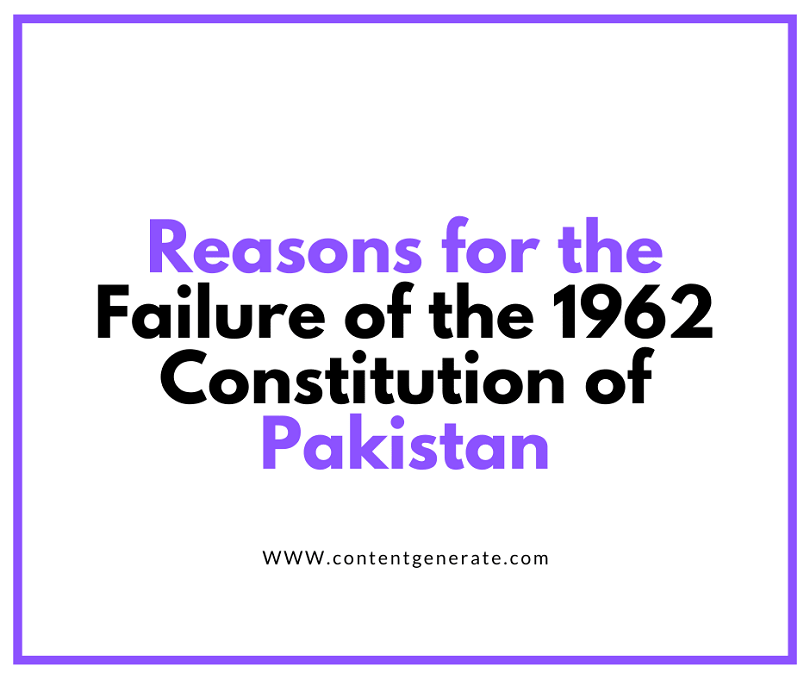Reasons for the Failure of the 1962 Constitution of Pakistan

This article discusses the reasons for the failure of the 1962 constitution of Pakistan.
Contents
Background
General Ayub Khan promulgated Pakistan’s second constitution in 1962 through a presidential ordinance. Like the 1956 constitution, the new constitution could not remain in action for longer. In the wake of fierce agitation against the military regime, Ayub Khan resigned as president in March 1969 and handed over the reign of the country to General Yahya. With his resignation, the 1962 Constitution was also suspended and Yahya assumed power as second Chief Martial Law administrator.
Reasons for the failure of the 1962 constitution
Following are considered to be some of the reasons responsible for the failure of the 1962 constitution of Pakistan:
1. One-man Show
The constitution was basically made to suit the political interests and prolong his rule in the country. It did not provide any chance and space for independent political activities. The office of the president was entrusted with powers without any mechanism of accountability. The president could use his powers disproportionately and no authority and court could challenge it.
2. Undemocratic Constitution
The constitution provided a controlled form of democracy in the country. People could not elect the government directly. Only Basic Democrats could be elected by people at the local level. The basic democrats acted as an electoral college for the election of the president, national assembly, and provincial legislatures. Ayub Khan as president used his influence to get him elected to the presidency in the 1965 presidential elections.
Moreover, the president could dismiss the national assembly, issue ordinances, and appoint ministers at his discretion. As president Ayub Khan was not answerable to anyone.
3. Parity of Representation
The constitution provided parity of representation at the center. East Pakistani politicians and people rejected and resented this provision of the principle of parity at the center. They demanded their representation proportional to their population which was 56% of the total population. For them, parity of representation meant an undemocratic act and political under-representation of the people of East Pakistan.
4. One Unit Formula
Like the 1956 constitution, the 1962 constitution also provided for the ‘One Unit Formula’. According to one unit scheme, the five provinces of West Pakistan i.e. Punjab, Sindh, NWFP, and Balochistan would merge together into a single unit instead of four different provinces. The people and east Pakistan politicians did not like the One-Unit Formula. The incorporation in the 1962 constitution just added to the grievances of the people.
5. Public Desire for the Parliamentary System
The 1962 Constitution provided a presidential form of government. People of Pakistan and politically conscious circles demanded a parliamentary system of government instead.
6. Repression and Curtailment of Fundamental Rights
Ayub Khan enjoyed unchallenged authority as per the 1962 Constitution. Although the constitution provided fundamental rights, the military regime did not hesitate in their violation if it suited its interests. The government imposed restrictions on the political parties and their activities. They could not speak against the government. The government reacted by picking up and torturing opponents for their protest, critique, and agitation.
7. Student Rise for Democracy
By the end of 1968, the youth and people of Pakistan had become fed up with Ayub Khan who ruled the country by strictly providing little space for democracy. Now people had started to challenge the arbitrary acts and dictatorial decisions. At the core of the agitation lay the student protests which had erupted throughout the country for the revival of democracy and civilian rule.
8. Rise of Bhutto
Zulfiqar Ali Bhutto had resigned as foreign minister in protest against Ayub’s approach while signing the Tashkent Agreement in 1966. Bhutto supported anti-Ayub student strikes aimed at getting the resignation of Ayub Khan and forming a directly elected government.
Students also challenged the indirect election system introduced in the 1962 Constitution of the country. Similar protests and agitation were also spreading against Ayub Khan in East Pakistan too.
9. Resignation of Ayub Khan
Ayub Khan resorted to using force to crush the uprising against his undemocratic rule in both wings of Pakistan. The agitation instead forced Ayub Khan to resign from the presidency thus bringing an end to his decade-long dictatorial rule. Ayub handed power over to the army chief, General Yahya Khan on March 25, 1969. Yahya Khan abrogated the 1962 constitution the same day and imposed martial law.




